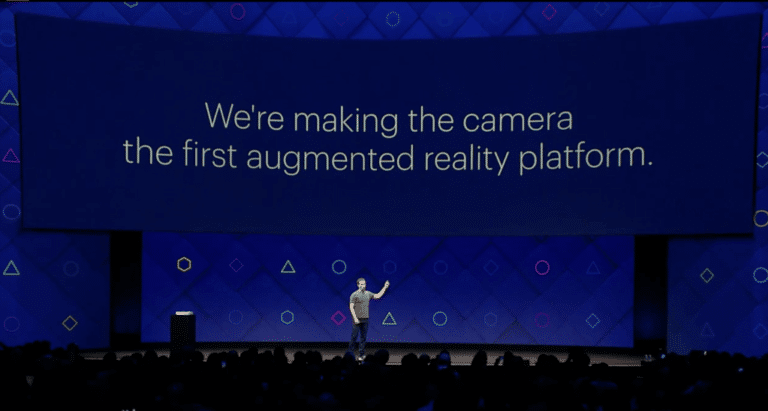
This article originally appeared in Street Fight, by the author of this post.
I’ve been obnoxiously bullish on native-social advertising over the past few years, including its potential to erode traditional display ads. Its growth will follow the trajectory of its supporting tech (mobile broadband, bigger screens, camera optics), as well as millennial affinities.
But another factor has emerged — where I’m also bullish — to boost that potential even further: augmented reality (AR). The two technologies converge in multimedia sharing on social apps (not new), adorned with contoured graphical overlays (semi-new).
This includes already-established media such as selfie lenses and 3D stickers, which aren’t “true AR.” But where it’s going is more interesting: using the rest of the physical world as a canvas for AR graphical overlays. Think: geotagged graphical notes left by friends at your local bar.
If this sounds familiar, it’s been the battle cry for AR for a while, including the ill-fated Google Glass. But what’s different now is the realization by tech giants that the smartphone — not smart glasses — is where the near-term opportunity lies, as I’ve been saying.
We saw it with Pokemon Go and of course Snapchat. But the real glimpse of the mobile AR future came during Facebook’s recent AR-studded F8 conference keynote. The central message repeated by Mark Zuckerberg was that the smartphone camera is the new AR platform.
Platform is the key word. Through Facebook’s new Camera Effects platform, developers get a set of tools tools to create AR graphics. Yes, that includes the standard fare of dog-face selfie lenses, but also new and practical AR use cases they’ll create.
For example, back to native-social ads, brands will get creative with AR overlays. Nike will offer selfie-adorning AR graphics for fitness milestones people want to share. For local advertising, think: pinning restaurant reviews or menu recommendations on physical locations.
Stepping back, it should be acknowledged that Snapchat already does something similar with Geofilters. But the key differentiators are Facebook’s open platform and its scale. We’ll end up with thousands of new graphics and use cases, instead of the tens that Snapchat offers.
That means Facebook’s innovation isn’t necessarily in product, but in business model. Indeed, the AR-heavy approach was plucked wholesale from Snapchat. But Facebook’s edge comes from a network effect that stems from 2 billion users and an army of outside developers.
But we shouldn’t discount Facebook’s product innovation. It has thrown lots of money at the computer vision and simultaneous location and mapping (SLAM) that render graphics to interact with the contours of the world in dimensionally accurate ways. In other words “true AR.”
The bottom line for local: the “ad inventory” for merchants to make themselves visible could extend beyond Google SERP’s and in-app presence like Yelp. It will soon include the physical areas in and around their stores (or competitors’ stores).
This could be a mess in terms of establishing ownership within this fourth dimension that overlays the real world. But it’s also a greenfield for local ad tech players to work with Facebook’s AR platform to bring it to local businesses. That includes things like tools to create branded graphics.
But the real game will be won on provisioning the virtual space. It could be a bid marketplace or a sort of real world “Pages.” And just like the mobile revolution before it, it will be about getting a massive volume of users on a platform so that inventory is valuable. Sound familiar?
